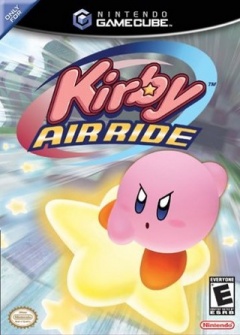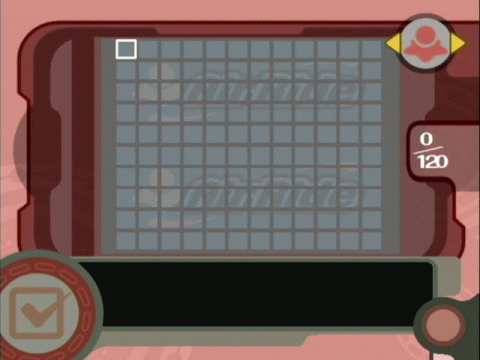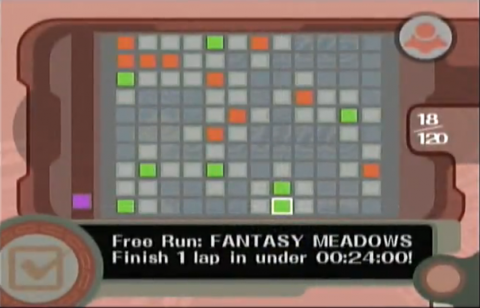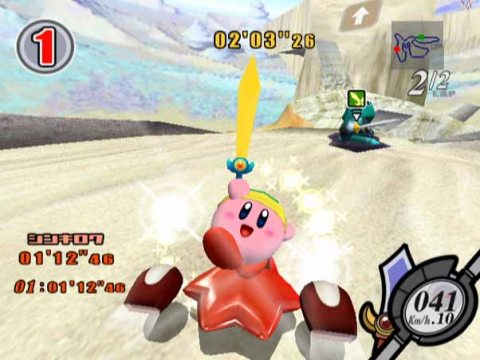Memorable Ideas from Forgettable Games - The Checklist Grid
| Kirby Air Ride | |
|---|---|
 |
|
| Platforms | Gamecube |
| Genre | Gluttonous Hovercraft Racer |
| Buy from Amazon | |
Some games are unforgettable. After forking over our birthday money
at K-Mart, we bounce all the way home in the backseat of the station wagon,
wrestle the plastic wrap away from the box, gingerly place the game in
the system, and steady our feverishly shaking hands with an anaconda
grip on the controller. We don't let go for hours. And when the
credits roll, we tear up a little, knowing we'll always cherish that
first time through.
And then there are games that are largely forgotten weeks after
release. Niche appeal, scathing reviews, or even just lack of hype
can doom a game to obscurity and the Target bargain bin. But even these games deserve a
second look...sometimes. Every once in a while, a kernel of brilliance
can be found within these steaming piles of mediocrity. The purpose of
this feature is to sift out some of these conceptual gems and put them under the
microscope.
Today we'll take a look at how the Checklist Grids in last generation's Kirby Air Ride add a special something to one of the current generation's biggest innovations: the Achievement.
Kirby Air Ride was a disappointment that spanned more than one generation. The game started cooking early in the N64 life cycle and didn't escape development hell until 2003, two years after Gamecube launched. It was met with mixed receptions for various reasons, though the most common outcry was "oversimplified!" The game was played entirely with the control stick and the Gamecube's gargantuan A button, which was used for breaking, drifting, inhaling, and activating Kirby's trademark copy abilities...all at the same time. Needless to say, the A button isn't the subject of this article.
Despite its core problems, the game featured a bevy of cool features. It included an enjoyable top-down racer mode a la classic Atari racing games. Its unique City Trial mode tasked players with building up their vehicle (and destroying opponents') in an arena for several minutes before presenting a random challenge (races, long jumps, deathmatches, etc.). And it all had a distinct Super Smash Bros feel to its presentation and matchmaking customizations.
The focus of this writing, however, is on Kirby Air Ride's Checklist Grids. Stop me if this sounds familiar: upon completing a distinct feat within a game, the player is rewarded with a congratulatory message. If you've picked up a console capable of outputting in HD, the familiar blip sounds that accompany Xbox 360's Achievements or Playstation 3's Trophies have probably just sounded off in your head, signaling that your gamer phallus has just taken on another inch.
But before achievements were Achievements, they were a Masahiro Sakurai staple. Every Super Smash Bros game since the Nintendo 64 original has featured notifications of character unlocks or playtime landmarks as they happened, and the congratulation was stored in some Options menu for posterity. This concept also made it into Kirby Air Ride, albeit in a more holistic, intriguing way.
Each of Kirby Air Ride's three modes - Air Ride, Top Ride, and City Trial - features a 12x10 grid of squares. Each square represents a challenge. Do the math and you'll compute that Kirby Air Ride offers 360 achievements to unlock, which is either an amusing coincidence or a jumping off point for conspiracy, depending on whether or not you've got your tin foil hat on.
Whatever your level of paranoia, you have to admit that three-hundred and sixty achievements is a lot. Most games with Achievements or Trophies in the current generation boast a number somewhere in the neighborhood of fifty. Kirby Air Ride does an admirable job of mixing up the challenges to get the most mileage out of the game's three play modes. Some are performance-based, such as the standard time trials or defeating X amount of enemies during a race. Others are contingent on play-time, unlocking after playing a course for X amount of time or completing X amount of laps. And the rest seem based on happenstance, like finishing a race while in the air or taking damage or spinning...odd little things that are likely to happen naturally. Many unlockables are also tied to these challenges, such as new characters, vehicles, music tracks and character colors, adding extra incentive to check out the Checklist Grid.
All of the challenges start out as secret, however. Each square begins blank, offering no hint as to how to complete the challenge it represents. Upon fulfilling the circumstances required, the square is stamped green (or orange if it houses an unlockable), and those surrounding it light up. Each of these lit squares then presents a new challenge, as well as your reward for completing it. Upon completing THOSE challenges, the squares around THEM are lit. Rather than presenting the player with a list, Kirby Air Ride requires the player to branch out from one unintentionally-completed challenge to the rest, discovering and completing each challenge without any established order.
The Grid turns the Achievement idea into a game of its own: instead of simply checking challenges off a list, the challenges themselves are secret, and uncovering each new item becomes its own objective. It's a simple interface change that adds a sense of discovery and open-endedness to each player's progression through a huge list of unlockables and achievables.
Another quality of Kirby Air Ride's Checklist Grids worth mentioning is that every challenge is available to try at any time, as long as you've unlocked the required course and/or vehicle. Even if the square that represents the challenge is still blank, it can still be attempted if you know it (or accidentally unlocked if you don't). All games with course or stage selection options have such advantages, but unfortunately not all games have course or stage selection options. Longer adventures would benefit from an alternative to overwriting save files.
For example, one Trophy in God of War requires that you "Kiss the Nyad," a creature seen only once in the course of the eight hour adventure. If you pass this easily-skippable portion of the game without puckering up - which is what happened, in my case - you cannot do it again in that playthrough. You would have to complete the entire first half of the game again in order to complete this trivial task. With several sequence-specific Trophies and only four save slots, the only way to ensure 100% completion of God of War's campaign Trophies on a first playthrough is to check them out beforehand (which will likely expose you to spoilers) and make a conscious effort to complete them as they come. Otherwise you're looking at a second playthrough with plenty of filler on the way to your OCD goal. Kirby Air Ride's setup isn't the only solution to this problem, but this problem is one that Kirby Air Ride's setup does solve.
It's unlikely we'll ever see another console without some sort of Gamerscore system. Sony and Microsoft clearly want it: both have already mandated and regulated Achievements and Trophies in all disc-based games. Developers definitely want it: the inexpensive system provides them with valuable research data, such as completion rates and average skill level. Players seem to want it, too: the extra challenges and system-wide scoring systems give many games added value, in their eyes. We can only hope, then, that the industry continues to look for ways to invigorate the Achievement concept. Kirby Air Ride wouldn't be a bad place to start.



